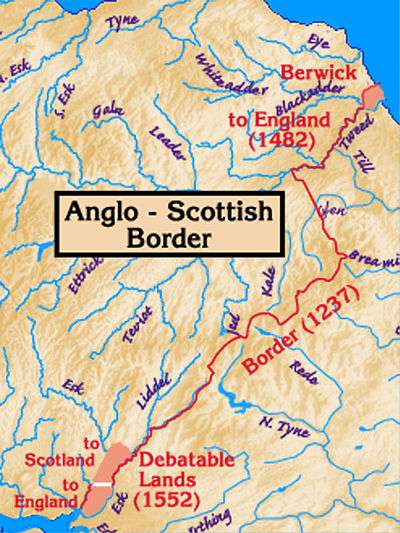Debatable Lands
The Debatable Lands, also known as debatable ground, batable ground or threip lands,[1] lay between Scotland and England.[2] It was formerly in question as to which it belonged, when they were distinct kingdoms.[3] The name either signifies litigious or disputable ground,[4] or it comes from the Old English word 'battable' (land suitable for fattening livestock).[5]

History
The Debatable Lands extended from the Solway Firth near Carlisle to Langholm in Dumfries and Galloway, the largest population centre being Canonbie.[6] The lands included the baronies of Kirkandrews, Bryntallone and Morton.[1] They were around ten miles (16 km) long from north to south and four miles (6.4 km) wide.[3] The boundaries were marked by the rivers Liddel and Esk in the east and the River Sark in the west.
A legal system indigenous to the area prevented settlement of it, and served to resolve disputes, but this broke down in the Middle Ages, in part because of interference by the English and Scottish crowns.[5] For over three hundred years the area was effectively controlled by local clans, such as the Armstrongs, who successfully resisted any attempt by the Scottish or English governments to impose their authority.[3] In his history of the Border Reivers (The Steel Bonnets, 1971), George MacDonald Fraser says that the Armstrongs alone could put 3,000 men in the field. They launched frequent raids on farms and settlements outside the Debatable Lands, the profits enabling them to become major landowners.
Other clans in the area were the Elwands, Ellwoods, or Eliotts who extended into Teviotdale; the Nixons who were more numerous in Cumberland; the Crossars in Upper Liddesdale, with their chief stronghold in Riccarton/Riccarton Mill (Rickerton, forms of Richardtown), Northern/Upper Liddesdale (listed in valleys of Liddesdale as locus/locality of Croyser 1376) of Hudhouse also located nearby on Liddel (it is a mistake to suppose they settled in Debatable lands on the lower Liddel though at Riccarton, and Hudhouse they were on the upper end of the Liddel Water);[7] and the Grahams, who owned five towers in the Debatable Land. The Irvings, Carruthers, Olivers, Bells, Dicksons, and Littles were also present in varying numbers.[1]
In 1530, King James V of Scotland took action against the lawless clans of the Debatable Lands and imprisoned the Lords Bothwell, Maxwell and Home, Walter Scott of Buccleuch, and other border lairds for their lack of action. James took various other steps, but significantly he broke the strength of the Armstrongs by hanging Johnnie Armstrong of Gilnockie and thirty-one others at Caerlanrig Chapel, under questionable circumstances.[8][3]
In 1552, Commissioners from Scotland and England met and divided the Debatable Lands between England and Scotland, with a line, known as the Scots' Dike, drawn from Esk to Sark,[9] abolishing the Debatable Lands' de facto independence from either crown.[3] Since then, the Anglo-Scottish border has remained essentially unchanged.
The 1552 division of the Debatable Lands, the Scots' Dike and the several changes to the status of Berwick-upon-Tweed between the thirteenth to fifteenth centuries until it finally became English in 1482, remains the only significant alterations to the border agreed in the 1237 Treaty of York,[3] making that treaty one of, if not the oldest, border treaties still in effect today.
In 1590 James VI of Scotland declared that the Debateable lands and the lands of Canonbie were annexed to the crown, and he set new leases various landowners.[10]
See also
Notes
- Maxwell 1897, p. 161.
- The County Histories of Scotland, Volume 5. Scotland: W. Blackwood and Sons. 1896. pp. 160–162. Retrieved 8 May 2018.
- Henton, Kirsten (5 May 2020). "The tiny 'country' between England and Scotland". BBC Travel. Retrieved 6 May 2020.
- Chambers 1728, p. 91.
- Graham Robb (2018). Debatable Land. Picador. ISBN 9781509804689.
- Dan O'Sullivan (2016). The Reluctant Ambassador: The Life and Times of Sir Thomas Chaloner, Tudor Diplomat. Amberley Publishing Limited. ISBN 9781445651651. Retrieved 8 May 2018.
- The History of Liddesdale, Eskdale, Ewesdale, Wauchopedale and the ..., Volume 1 By Robert Bruce Armstrong pg 181-2
- Maxwell 1897, pp. 161–167.
- "Debatable Land". www.geog.port.ac.uk. Retrieved 31 August 2019.
- David Masson, Register of the Privy Council of Scotland: 1585-1592, vol. 4 (Edinburgh, 1881), pp. 799-800.
References
- Maxwell, Sir Herbert (1897). A History of Dumfries and Galloway. Edinburgh: William Blackwood and Sons. pp. 161–167.CS1 maint: ref=harv (link)
- Attribution

Further reading
- Robb, Graham (2018). The Debatable Land. Picador. ISBN 978-1-5098-0468-9.
- Robson, Eric (2006). The Border Line. Frances Lincoln Ltd.
- Mack, James Logan (1926). The Border Line. Oliver & Boyd.
- "Romanticism's Debatable Lands". The British Association for Romantic Studies, Biennial Conference. University of Newcastle upon Tyne. 28–31 July 2005. Archived from the original on 20 February 2007. Retrieved 9 April 2007.
- "Debatable Lands". Border Reivers Website.
- BBC staff. "A village on debatable land... The small village of Bewcastle". BBC.
- "A Researcher's Guide to Local History terminology".